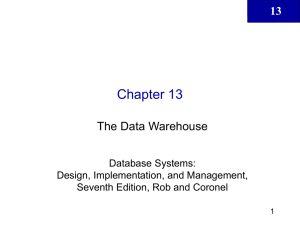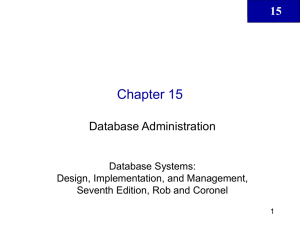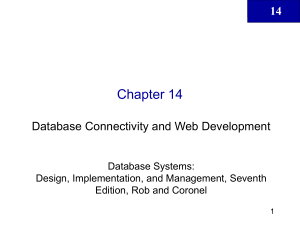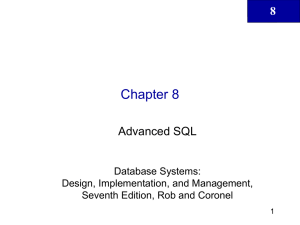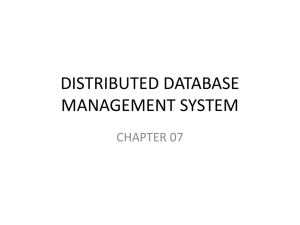Chapter 7 - Websupport1
advertisement
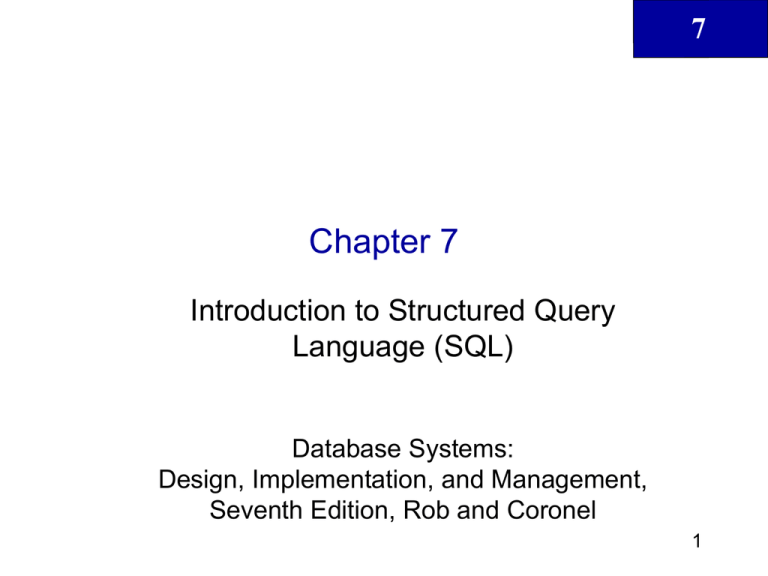
7 Chapter 7 Introduction to Structured Query Language (SQL) Database Systems: Design, Implementation, and Management, Seventh Edition, Rob and Coronel 1 7 In this chapter, you will learn: • The basic commands and functions of SQL • How to use SQL for data administration (to create tables, indexes, and views) • How to use SQL for data manipulation (to add, modify, delete, and retrieve data) • How to use SQL to query a database to extract useful information Database Systems: Design, Implementation, & Management, 7th Edition, Rob & Coronel 2 7 Introduction to SQL • SQL functions fit into two broad categories: – Data definition language • SQL includes commands to: – Create database objects, such as tables, indexes, and views – Define access rights to those database objects – Data manipulation language • Includes commands to insert, update, delete, and retrieve data within database tables Database Systems: Design, Implementation, & Management, 7th Edition, Rob & Coronel 3 7 Introduction to SQL (continued) • SQL is relatively easy to learn • Basic command set has vocabulary of less than 100 words • Nonprocedural language • American National Standards Institute (ANSI) prescribes a standard SQL • Several SQL dialects exist Database Systems: Design, Implementation, & Management, 7th Edition, Rob & Coronel 4 7 Introduction to SQL (continued) Database Systems: Design, Implementation, & Management, 7th Edition, Rob & Coronel 5 7 Introduction to SQL (continued) Database Systems: Design, Implementation, & Management, 7th Edition, Rob & Coronel 6 7 Introduction to SQL (continued) Database Systems: Design, Implementation, & Management, 7th Edition, Rob & Coronel 7 7 Data Definition Commands • Examine simple database model and database tables that will form basis for many SQL examples • Understand data environment Database Systems: Design, Implementation, & Management, 7th Edition, Rob & Coronel 8 7 The Database Model Database Systems: Design, Implementation, & Management, 7th Edition, Rob & Coronel 9 7 The Database Model (continued) Database Systems: Design, Implementation, & Management, 7th Edition, Rob & Coronel 10 7 Creating the Database • Following two tasks must be completed: – Create database structure – Create tables that will hold end-user data • First task: – RDBMS creates physical files that will hold database – Tends to differ substantially from one RDBMS to another Database Systems: Design, Implementation, & Management, 7th Edition, Rob & Coronel 11 7 The Database Schema • Authentication – Process through which DBMS verifies that only registered users are able to access database – Log on to RDBMS using user ID and password created by database administrator • Schema – Group of database objects—such as tables and indexes—that are related to each other Database Systems: Design, Implementation, & Management, 7th Edition, Rob & Coronel 12 7 Data Types • Data type selection is usually dictated by nature of data and by intended use • Pay close attention to expected use of attributes for sorting and data retrieval purposes Database Systems: Design, Implementation, & Management, 7th Edition, Rob & Coronel 13 7 Data Types (continued) Database Systems: Design, Implementation, & Management, 7th Edition, Rob & Coronel 14 7 Creating Table Structures • Use one line per column (attribute) definition • Use spaces to line up attribute characteristics and constraints • Table and attribute names are capitalized • NOT NULL specification • UNIQUE specification Database Systems: Design, Implementation, & Management, 7th Edition, Rob & Coronel 15 7 Creating Table Structures (continued) • Primary key attributes contain both a NOT NULL and a UNIQUE specification • RDBMS will automatically enforce referential integrity for foreign keys • Command sequence ends with semicolon Database Systems: Design, Implementation, & Management, 7th Edition, Rob & Coronel 16 7 SQL Constraints • NOT NULL constraint – Ensures that column does not accept nulls • UNIQUE constraint – Ensures that all values in column are unique • DEFAULT constraint – Assigns value to attribute when a new row is added to table • CHECK constraint – Validates data when attribute value is entered Database Systems: Design, Implementation, & Management, 7th Edition, Rob & Coronel 17 7 SQL Indexes • When primary key is declared, DBMS automatically creates unique index • Often need additional indexes • Using CREATE INDEX command, SQL indexes can be created on basis of any selected attribute • Composite index – Index based on two or more attributes – Often used to prevent data duplication Database Systems: Design, Implementation, & Management, 7th Edition, Rob & Coronel 18 7 SQL Indexes (continued) Database Systems: Design, Implementation, & Management, 7th Edition, Rob & Coronel 19 7 Data Manipulation Commands • Adding table rows • Saving table changes • Listing table rows • Updating table rows • Restoring table contents • Deleting table rows • Inserting table rows with a select subquery Database Systems: Design, Implementation, & Management, 7th Edition, Rob & Coronel 20 7 Adding Table Rows • INSERT – Used to enter data into table – Syntax: • INSERT INTO columnname VALUES (value1, value2, … , valuen); Database Systems: Design, Implementation, & Management, 7th Edition, Rob & Coronel 21 7 Adding Table Rows (continued) • When entering values, notice that: – Row contents are entered between parentheses – Character and date values are entered between apostrophes – Numerical entries are not enclosed in apostrophes – Attribute entries are separated by commas – A value is required for each column • Use NULL for unknown values Database Systems: Design, Implementation, & Management, 7th Edition, Rob & Coronel 22 7 Saving Table Changes • Changes made to table contents are not physically saved on disk until, one of the following occurs: – Database is closed – Program is closed – COMMIT command is used • Syntax: – COMMIT [WORK]; • Will permanently save any changes made to any table in the database Database Systems: Design, Implementation, & Management, 7th Edition, Rob & Coronel 23 7 Listing Table Rows • SELECT – Used to list contents of table – Syntax: • SELECT columnlist FROM tablename; • Columnlist represents one or more attributes, separated by commas • Asterisk can be used as wildcard character to list all attributes Database Systems: Design, Implementation, & Management, 7th Edition, Rob & Coronel 24 7 Listing Table Rows (continued) Database Systems: Design, Implementation, & Management, 7th Edition, Rob & Coronel 25 7 Updating Table Rows • UPDATE – Modify data in a table – Syntax: • UPDATE tablename SET columnname = expression [, columname = expression] [WHERE conditionlist]; • If more than one attribute is to be updated in row, separate corrections with commas Database Systems: Design, Implementation, & Management, 7th Edition, Rob & Coronel 26 7 Restoring Table Contents • ROLLBACK – Used to restore database to its previous condition – Only applicable if COMMIT command has not been used to permanently store changes in database • Syntax: – ROLLBACK; • COMMIT and ROLLBACK only work with data manipulation commands that are used to add, modify, or delete table rows Database Systems: Design, Implementation, & Management, 7th Edition, Rob & Coronel 27 7 Deleting Table Rows • DELETE – Deletes a table row – Syntax: • DELETE FROM tablename [WHERE conditionlist ]; • WHERE condition is optional • If WHERE condition is not specified, all rows from specified table will be deleted Database Systems: Design, Implementation, & Management, 7th Edition, Rob & Coronel 28 7 Inserting Table Rows with a Select Subquery • INSERT – Inserts multiple rows from another table (source) – Uses SELECT subquery • Query that is embedded (or nested) inside another query • Executed first – Syntax: • INSERT INTO tablename SELECT columnlist FROM tablename; Database Systems: Design, Implementation, & Management, 7th Edition, Rob & Coronel 29 7 Selecting Rows with Conditional Restrictions • Select partial table contents by placing restrictions on rows to be included in output – Add conditional restrictions to SELECT statement, using WHERE clause • Syntax: – SELECT columnlist FROM tablelist [ WHERE conditionlist ] ; Database Systems: Design, Implementation, & Management, 7th Edition, Rob & Coronel 30 7 Selecting Rows with Conditional Restrictions (continued) Database Systems: Design, Implementation, & Management, 7th Edition, Rob & Coronel 31 Selecting Rows with Conditional Restrictions (continued) Database Systems: Design, Implementation, & Management, 7th Edition, Rob & Coronel 7 32 7 Selecting Rows with Conditional Restrictions (continued) Database Systems: Design, Implementation, & Management, 7th Edition, Rob & Coronel 33 7 Selecting Rows with Conditional Restrictions (continued) Database Systems: Design, Implementation, & Management, 7th Edition, Rob & Coronel 34 7 Selecting Rows with Conditional Restrictions (continued) Database Systems: Design, Implementation, & Management, 7th Edition, Rob & Coronel 35 7 Selecting Rows with Conditional Restrictions (continued) Database Systems: Design, Implementation, & Management, 7th Edition, Rob & Coronel 36 7 Selecting Rows with Conditional Restrictions (continued) Database Systems: Design, Implementation, & Management, 7th Edition, Rob & Coronel 37 7 Selecting Rows with Conditional Restrictions (continued) Database Systems: Design, Implementation, & Management, 7th Edition, Rob & Coronel 38 7 Selecting Rows with Conditional Restrictions (continued) Database Systems: Design, Implementation, & Management, 7th Edition, Rob & Coronel 39 7 Arithmetic Operators: The Rule of Precedence • Perform operations within parentheses • Perform power operations • Perform multiplications and divisions • Perform additions and subtractions Database Systems: Design, Implementation, & Management, 7th Edition, Rob & Coronel 40 7 Arithmetic Operators: The Rule of Precedence (continued) Database Systems: Design, Implementation, & Management, 7th Edition, Rob & Coronel 41 7 Logical Operators: AND, OR, and NOT Database Systems: Design, Implementation, & Management, 7th Edition, Rob & Coronel 42 7 Logical Operators: AND, OR, and NOT (continued) Database Systems: Design, Implementation, & Management, 7th Edition, Rob & Coronel 43 7 Logical Operators: AND, OR, and NOT (continued) Database Systems: Design, Implementation, & Management, 7th Edition, Rob & Coronel 44 7 Special Operators • BETWEEN – Used to check whether attribute value is within a range • IS NULL – Used to check whether attribute value is null • LIKE – Used to check whether attribute value matches given string pattern Database Systems: Design, Implementation, & Management, 7th Edition, Rob & Coronel 45 7 Special Operators (continued) • IN – Used to check whether attribute value matches any value within a value list • EXISTS – Used to check if subquery returns any rows Database Systems: Design, Implementation, & Management, 7th Edition, Rob & Coronel 46 7 Advanced Data Definition Commands • All changes in table structure are made by using ALTER command – Followed by keyword that produces specific change – Following three options are available: • ADD • MODIFY • DROP Database Systems: Design, Implementation, & Management, 7th Edition, Rob & Coronel 47 7 Changing a Column’s Data Type • ALTER can be used to change data type • Some RDBMSs (such as Oracle) do not permit changes to data types unless column to be changed is empty Database Systems: Design, Implementation, & Management, 7th Edition, Rob & Coronel 48 7 Changing a Column’s Data Characteristics • Use ALTER to change data characteristics • If column to be changed already contains data, changes in column’s characteristics are permitted if those changes do not alter the data type Database Systems: Design, Implementation, & Management, 7th Edition, Rob & Coronel 49 7 Adding a Column • Use ALTER to add column – Do not include the NOT NULL clause for new column Database Systems: Design, Implementation, & Management, 7th Edition, Rob & Coronel 50 7 Dropping a Column • Use ALTER to drop column – Some RDBMSs impose restrictions on the deletion of an attribute Database Systems: Design, Implementation, & Management, 7th Edition, Rob & Coronel 51 7 Advanced Data Updates Database Systems: Design, Implementation, & Management, 7th Edition, Rob & Coronel 52 7 Copying Parts of Tables • SQL permits copying contents of selected table columns so that the data need not be reentered manually into newly created table(s) • First create the PART table structure • Next add rows to new PART table using PRODUCT table rows Database Systems: Design, Implementation, & Management, 7th Edition, Rob & Coronel 53 7 Copying Parts of Tables (continued) Database Systems: Design, Implementation, & Management, 7th Edition, Rob & Coronel 54 7 Adding Primary and Foreign Key Designations • When table is copied, integrity rules do not copy, so primary and foreign keys need to be manually defined on new table • User ALTER TABLE command – Syntax: • ALTER TABLE tablename ADD PRIMARY KEY(fieldname); • For foreign key, use FOREIGN KEY in place of PRIMARY KEY Database Systems: Design, Implementation, & Management, 7th Edition, Rob & Coronel 55 7 Deleting a Table from the Database • DROP – Deletes table from database – Syntax: • DROP TABLE tablename; Database Systems: Design, Implementation, & Management, 7th Edition, Rob & Coronel 56 7 Advanced Select Queries • SQL provides useful functions that can: – Count – Find minimum and maximum values – Calculate averages • SQL allows user to limit queries to only those entries having no duplicates or entries whose duplicates may be grouped Database Systems: Design, Implementation, & Management, 7th Edition, Rob & Coronel 57 7 Ordering a Listing Database Systems: Design, Implementation, & Management, 7th Edition, Rob & Coronel 58 7 Ordering a Listing (continued) Database Systems: Design, Implementation, & Management, 7th Edition, Rob & Coronel 59 7 Ordering a Listing (continued) Database Systems: Design, Implementation, & Management, 7th Edition, Rob & Coronel 60 7 Listing Unique Values Database Systems: Design, Implementation, & Management, 7th Edition, Rob & Coronel 61 7 Aggregate Functions Database Systems: Design, Implementation, & Management, 7th Edition, Rob & Coronel 62 7 Aggregate Functions (continued) Database Systems: Design, Implementation, & Management, 7th Edition, Rob & Coronel 63 7 Aggregate Functions (continued) Database Systems: Design, Implementation, & Management, 7th Edition, Rob & Coronel 64 7 Aggregate Functions (continued) Database Systems: Design, Implementation, & Management, 7th Edition, Rob & Coronel 65 7 Aggregate Functions (continued) Database Systems: Design, Implementation, & Management, 7th Edition, Rob & Coronel 66 7 Grouping Data Database Systems: Design, Implementation, & Management, 7th Edition, Rob & Coronel 67 7 Grouping Data (continued) Database Systems: Design, Implementation, & Management, 7th Edition, Rob & Coronel 68 7 Grouping Data (continued) Database Systems: Design, Implementation, & Management, 7th Edition, Rob & Coronel 69 7 Virtual Tables: Creating a View • View is virtual table based on SELECT query – Can contain columns, computed columns, aliases, and aggregate functions from one or more tables • Base tables are tables on which view is based • Create view by using CREATE VIEW command Database Systems: Design, Implementation, & Management, 7th Edition, Rob & Coronel 70 7 Virtual Tables: Creating a View (continued) Database Systems: Design, Implementation, & Management, 7th Edition, Rob & Coronel 71 7 Joining Database Tables • Ability to combine (join) tables on common attributes is most important distinction between relational database and other databases • Join is performed when data are retrieved from more than one table at a time • Join is generally composed of an equality comparison between foreign key and primary key of related tables Database Systems: Design, Implementation, & Management, 7th Edition, Rob & Coronel 72 7 Joining Database Tables (continued) Database Systems: Design, Implementation, & Management, 7th Edition, Rob & Coronel 73 7 Joining Database Tables (continued) Database Systems: Design, Implementation, & Management, 7th Edition, Rob & Coronel 74 7 Joining Database Tables (continued) Database Systems: Design, Implementation, & Management, 7th Edition, Rob & Coronel 75 7 Joining Tables with an Alias • Alias can be used to identify source table • Any legal table name can be used as alias • Add alias after table name in FROM clause – FROM tablename alias Database Systems: Design, Implementation, & Management, 7th Edition, Rob & Coronel 76 7 Recursive Joins Database Systems: Design, Implementation, & Management, 7th Edition, Rob & Coronel 77 7 Recursive Joins (continued) Database Systems: Design, Implementation, & Management, 7th Edition, Rob & Coronel 78 7 Outer Joins Database Systems: Design, Implementation, & Management, 7th Edition, Rob & Coronel 79 7 Outer Joins (continued) Database Systems: Design, Implementation, & Management, 7th Edition, Rob & Coronel 80 7 Summary • SQL commands can be divided into two overall categories: – Data definition language commands – Data manipulation language commands • The ANSI standard data types are supported by all RDBMS vendors in different ways • Basic data definition commands allow you to create tables, indexes, and views Database Systems: Design, Implementation, & Management, 7th Edition, Rob & Coronel 81 7 Summary (continued) • DML commands allow you to add, modify, and delete rows from tables • The basic DML commands are SELECT, INSERT, UPDATE, DELETE, COMMIT, and ROLLBACK • INSERT command is used to add new rows to tables • SELECT statement is main data retrieval command in SQL Database Systems: Design, Implementation, & Management, 7th Edition, Rob & Coronel 82 7 Summary (continued) • Many SQL constraints can be used with columns • The column list represents one or more column names separated by commas • WHERE clause can be used with SELECT, UPDATE, and DELETE statements to restrict rows affected by the DDL command Database Systems: Design, Implementation, & Management, 7th Edition, Rob & Coronel 83 7 Summary (continued) • Aggregate functions – Special functions that perform arithmetic computations over a set of rows • ORDER BY clause – Used to sort output of SELECT statement – Can sort by one or more columns and use either an ascending or descending order • Join output of multiple tables with SELECT statement Database Systems: Design, Implementation, & Management, 7th Edition, Rob & Coronel 84 7 Summary (continued) • Natural join uses join condition to match only rows with equal values in specified columns • Right outer join and left outer join used to select rows that have no matching values in other related table Database Systems: Design, Implementation, & Management, 7th Edition, Rob & Coronel 85
